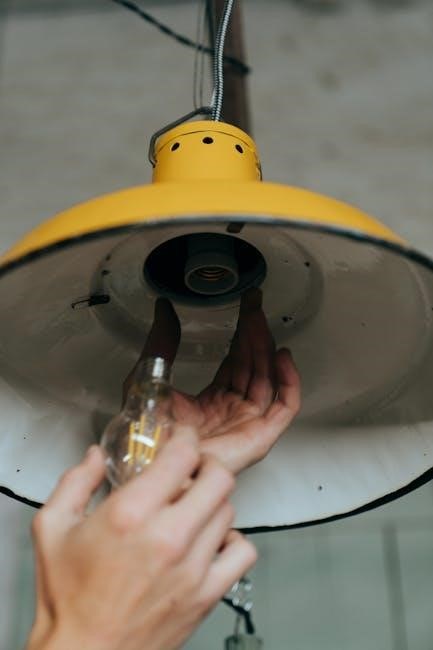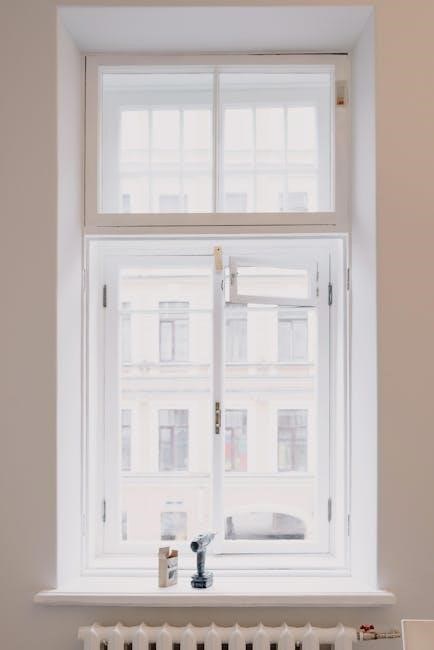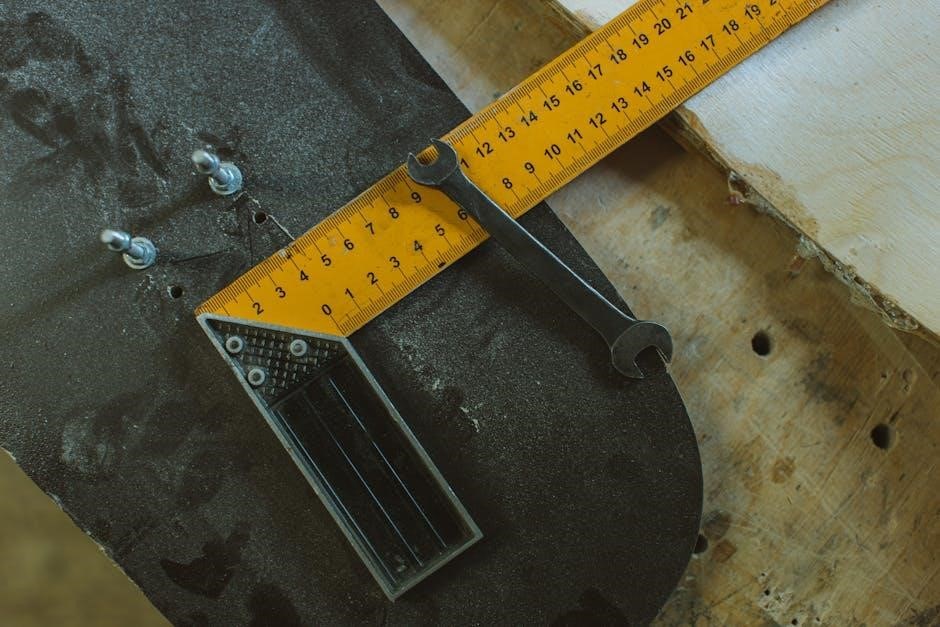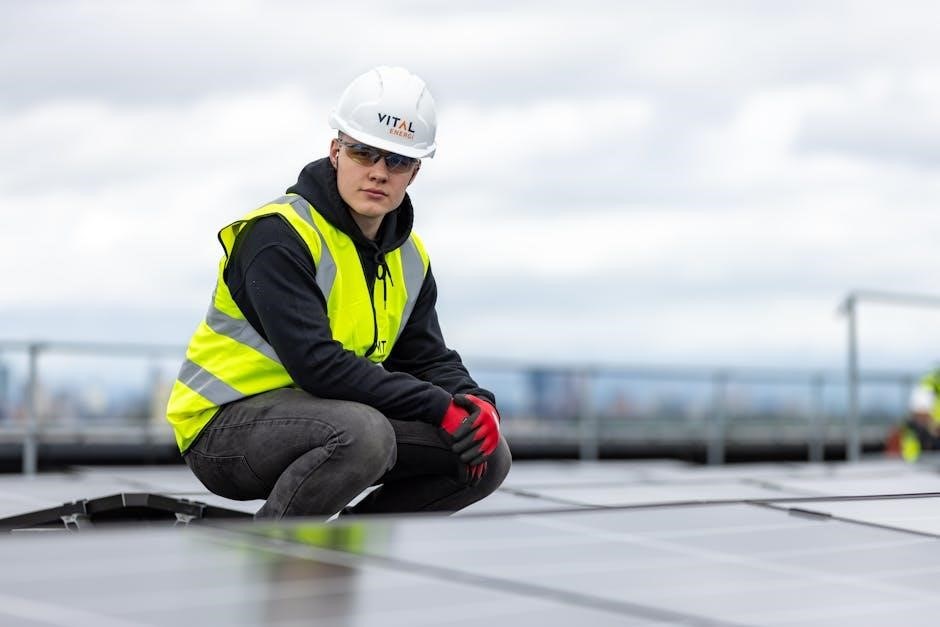Welcome to the Honeywell FocusPro TH6110D1005 installation manual. This guide provides comprehensive instructions for installing, configuring, and maintaining this programmable thermostat, ensuring optimal performance in various heating and cooling systems.

Pre-Installation Checklist

- Verify system compatibility with 1 Heat/1 Cool systems.
- Check power options (24VAC or batteries) and ensure all parts are included.
- Choose a location with good air circulation, avoiding direct sunlight or drafts.
2.1. System Compatibility
The Honeywell FocusPro TH6110D1005 is designed for compatibility with single-stage heating and cooling systems, including gas, oil, and electric configurations. It works seamlessly with conventional 24VAC systems, heat pumps, and 750mV heating systems. The thermostat supports various system types such as heat only, cool only, and combined heating and cooling setups. It is also compatible with two-wire systems for heat-only configurations. Additionally, it can integrate with zone valves and fan controls, making it versatile for different installations. Always ensure the thermostat matches your system type to avoid operational issues. For detailed compatibility, refer to the wiring diagrams and system requirements in the manual. Proper system matching ensures efficient performance and prevents potential malfunctions.

2.2. Power Requirements
The Honeywell FocusPro TH6110D1005 thermostat requires a 24VAC power supply or can be powered by batteries. For AC power, connect the common side of the cooling transformer to the C terminal. In 2-transformer systems, remove the R/Rc jumper (refer to the wiring diagram on page 5). Battery power is optional and provides backup during outages, saving time/day settings and display functionality. Batteries can be replaced easily without removing the thermostat from the wall. Ensure proper power setup to avoid electrical hazards. Always disconnect power before wiring or servicing the thermostat. The thermostat is designed for efficient operation with minimal power consumption, ensuring reliability and performance in various heating and cooling systems. Proper power configuration is critical for safe and optimal functionality.

Wallplate Installation
Remove the wallplate from the thermostat and pull wires through the wire hole. Position the wallplate on the wall, level it, and mark hole positions with a pencil. Drill holes and secure the wallplate for proper mounting.
3.1. Wiring Instructions
Disconnect power before starting wiring to avoid electrical hazards. Connect the common side of the cooling transformer to the C terminal. Remove the R/Rc jumper for 2-transformer systems. Refer to the wiring diagram for specific connections, such as 1H/1C systems or heat pumps. Ensure all wires are securely attached to their respective terminals. For battery-powered setups, install the batteries after wiring. If using AC power, ensure the R and Rc terminals are configured correctly. Double-check connections to avoid mismatches. After wiring, mount the thermostat and test functionality. Always follow safety precautions to prevent damage or electrical shock. Proper wiring ensures reliable operation of your Honeywell FocusPro TH6110D1005 thermostat. If unsure, consult a professional technician.
3.2. Power Options and Mounting
The Honeywell FocusPro TH6110D1005 offers flexible power options, including 24 VAC power or battery operation. For AC power, connect the common side of the cooling transformer to the C terminal and remove the R/Rc jumper for 2-transformer systems. Battery power provides backup during outages, saving time/day settings and powering the display. To mount, align the wallplate tabs with the thermostat slots and gently push until it snaps into place. Ensure the thermostat is installed 5 feet above the floor in an area with good air circulation, avoiding direct sunlight or drafts. Proper mounting ensures accurate temperature sensing. Follow these steps to secure the thermostat firmly and connect power safely. This setup ensures reliable operation and convenient battery replacement without removing the thermostat from the wall. Always disconnect power before wiring to prevent electrical hazards. Proper installation is key to optimal performance.

Configuration and Setup
Configure the thermostat to match your heating/cooling system, customize features, and set up functions like Auto Changeover, Adaptive Recovery, and compressor protection. Follow on-screen instructions to ensure proper functionality and optimal performance.
4.1. Auto Changeover (Setup Function 12)
Auto Changeover (Setup Function 12) allows the thermostat to automatically switch between heating and cooling modes based on the indoor temperature. This feature is ideal for climates where both heating and cooling are needed throughout the day. To enable Auto Changeover, navigate to the setup menu and select Function 12, then choose the “Auto” option. The thermostat will then automatically determine whether to activate the heating or cooling system to maintain the set temperature. A 3-degree deadband is maintained between heating and cooling setpoints to prevent simultaneous operation of both systems. This feature ensures efficient temperature control and reduces manual adjustments, making it convenient for users to maintain a consistent comfort level without constant thermostat changes. Proper configuration ensures smooth transitions between modes, optimizing energy use and system performance. Always refer to the installation manual for specific setup instructions to avoid any issues during operation.
4.2. Adaptive Intelligent Recovery (Setup Function 13)
Adaptive Intelligent Recovery (Setup Function 13) is a feature designed to optimize temperature control by learning how long your HVAC system takes to reach the desired temperature. This feature eliminates guesswork when setting your schedule, ensuring your home is at the preferred temperature exactly when you want it. By programming your schedule with the desired time and temperature, the thermostat calculates the optimal start time for heating or cooling, accounting for system performance and environmental factors. For example, if you set your “Wake” time to 6 AM and the temperature to 70°F, the thermostat will activate the system early enough to reach the target temperature by 6 AM. This feature enhances comfort and energy efficiency by avoiding unnecessary operation. To enable Adaptive Intelligent Recovery, navigate to the setup menu, select Function 13, and follow the on-screen instructions to configure your schedule. Proper use of this feature ensures seamless temperature control and improved system performance. Always refer to the manual for detailed setup steps and customization options.
4.3. Built-in Compressor Protection (Setup Function 15)
The Honeywell FocusPro TH6110D1005 thermostat includes a Built-in Compressor Protection feature (Setup Function 15) to prevent damage to your air conditioning or heat pump system. This feature ensures the compressor is not restarted too soon after shutdown, which could cause equipment damage. When the compressor turns off, the thermostat enforces a mandatory wait period before it can restart. During this time, the display may flash messages like “Cool On” or “Heat On” to indicate the compressor is in a protected state. Once the safe wait period expires, the message stops flashing, and the compressor resumes operation. This feature is essential for maintaining the longevity of your HVAC system. It is automatically enabled and requires no user adjustment, though advanced settings can be configured if needed. Ensure this feature is not bypassed, as it is critical for protecting your equipment. Refer to page 10 of the manual for detailed configuration options and additional information. Proper use of this feature ensures reliable operation and extends the lifespan of your system components. Always follow the manufacturer’s guidelines to avoid potential damage.
4.4. Testing Heating, Cooling, and Fan Operation

After installation and configuration, it is essential to test the heating, cooling, and fan operation to ensure proper functionality. Start by setting the thermostat to the heating mode and adjusting the temperature to a level that requires heating. Verify that the heating system activates and the fan operates correctly. Repeat this process for the cooling mode, ensuring the cooling system and fan engage as expected. Additionally, test the fan operation independently to confirm it works in all speed settings (if applicable). During testing, monitor the thermostat display for status indicators like “Heat On” or “Cool On” to confirm the system is responding. Avoid rapid cycling of the compressor during testing to prevent potential damage. If any issues arise, refer to the troubleshooting section of the manual. Proper testing ensures all components are functioning as intended and provides peace of mind for reliable HVAC performance. Always follow the manufacturer’s guidelines during this process.

Troubleshooting and Maintenance
Address common issues like temperature settings not changing or systems not responding. Check wiring, batteries, and system settings. Regularly clean the thermostat and inspect wires for damage. Replace batteries annually for optimal performance.
5.1. Common Issues and Solutions
Common issues with the Honeywell TH6110D1005 thermostat include temperature settings not changing, heating or cooling systems not responding, or the display not operating correctly. For temperature issues, ensure setpoints are within acceptable ranges (typically 35°F to 99°F). If the heating or cooling system does not respond, verify that the power source is stable and wiring connections are secure. Check for loose or corroded wires, as these can disrupt communication between components.

If the display is blank or unresponsive, replace the batteries or ensure AC power is connected properly. If the thermostat indicates “Heat On” or “Cool On” but the system does not activate, verify system settings and ensure the correct mode is selected. For heat pumps, check that the changeover valve is configured correctly. If the compressor protector is engaged, wait the required time before restarting the system. Regularly cleaning the thermostat and inspecting wires can prevent many issues. For persistent problems, refer to the troubleshooting section or contact a professional. Annual battery replacement and system checks are recommended to maintain optimal performance.
5.2. Maintenance Tips
Regular maintenance ensures optimal performance and extends the lifespan of your Honeywell TH6110D1005 thermostat. Start by replacing batteries annually or as indicated by low-battery alerts to prevent shutdowns. Clean the thermostat face and sensors with a soft cloth to avoid dust buildup, which can affect temperature accuracy. Inspect wiring connections periodically to ensure they are secure and free from corrosion. For systems with air conditioning, check and clean air filters every month to maintain proper airflow and efficiency.
- Replace batteries without removing the thermostat using the easy-access door.
- Verify wiring connections are tight and undamaged to prevent malfunctions.
- Ensure the thermostat is mounted level and in an area with good air circulation.
- Perform seasonal checks to confirm heating and cooling modes are functioning correctly.
- Refer to the user manual for specific maintenance schedules and procedures.
By following these tips, you can ensure your Honeywell TH6110D1005 operates efficiently and reliably, providing consistent comfort and energy savings. Proper care also reduces the risk of unexpected issues, keeping your home climate-controlled all year round. Always dispose of old batteries and materials responsibly.
